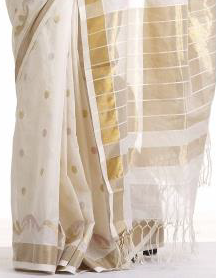Venkatagiri Cotton Saree
Venkatagiri Cotton Saree
Back ground
Venkatagiri is a small town situated about 60 kms away from Nellore in Andhra Pradesh. Weaving at Venkatagiri first originated over 300 years ago and was patronized by the “Velugoti“ dynasty. A small group of weavers were supported by the dynasty for the exclusive purpose of weaving dhoti and turbans made of soft cotton with sophisticated embroidery to the Royal family. Gradually the weavers started moving into saree weaving which was exclusively made for the queens, royal women and other zamindar.

Material utilised
In olden days, the saree used to be woven with super fine 120s cotton yarn in warp and weft with border zari “kaddi Anchu”(Plain zari stripe). At present it is eminently a cotton saree woven in fine 100s cotton yarn in both warp and weft. The saree is ornamented with zari in pallow and border. Jacquards are used to weave extra weft designs. Generally, soft and pastel colours are used in the sari.
Technique applied
The saree is woven on a traditional fly shuttle pit loom. The shuttles used for weaving are comparatively longer to the other fly shuttles Jacquard is used for weaving of extra weft designs. Zari is used in extra weft for ornamentation of the designs. Rope let-off motion and pocker rod take-up motions are employed. Though this saree used to be woven white but now pastel colours and designs are being woven as per taste of the market.
How to distinguish genuine venkatagiri saree
- Venkatagiri saree is not having very compact texture as compared to Balrampuram Sari.
- Borders have plain Zari stripe without extra warp design
- Small extra weft design in body and pallow with zari adds beauty to the Venkatagiri saree.
- Generally it is light coloured, light weight and soft to touch since very less designing is done and also less starch is put on yarns.
Source : India Handloom Brand
Last Modified : 9/7/2023
This topic provides information about Pochhampally...
This topic provides information about Tweed.
This topic provides information about Uppada Jamda...
This topic provides information about Tussar Gichh...
